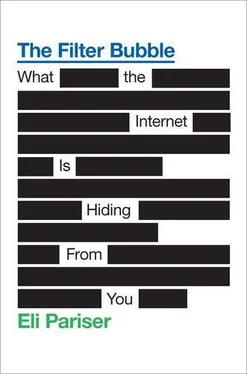I’ve saved the greatest and most personal debts for last. I’ve benefited immeasurably in my life from a string of great teachers: to name a few, Karen Scott, Doug Hamill, and Leslie Simmons at Lincolnville Central School; Jon Potter and Rob Lovell at Camden-Rockport High; and Barbara Resnik and Peter Cocks at Simon’s Rock, among others. Whatever perspicuity I have I owe these folks. And I’m lucky enough to have some truly wonderful friends. I can’t list all of you here, but you know who you are. I’m especially grateful for the support and love I’ve received—in good times and bad—from Aram and Lara Kailian, Tate Hausman, Noah T. Winer, Nick Arons, and Ben and Beth Wikler. It’s one of my goals in life to be as good a friend as you’ve been to me.
My family has also encouraged me and sharpened my thinking every step of the way. Big hugs and even bigger thank-yous to my mother, Dora Lievow, my father and stepmother, Emanuel Pariser and Lea Girardin, and my sister, Ya Jia. Eben Pariser, my brother, not only egged me on but made amazing pizza when I was flagging and helped finalize the manuscript. He’s as good a brother as he is a musician (check out his band, Roosevelt Dime, and you’ll see how high that compliment is). Bronwen Rice may not be an official family member, but I’ll include her here anyway: Bronwen, thanks for keeping me true to myself all of these years.
There are four final people whose generosity, intelligence, and love I appreciate more than I can fully express:
Wes Boyd took a big gamble on a twenty-one-year-old, trusted me more than I trusted myself, and mentored me through eight years at MoveOn. This book draws on many of our conversations over the years—there’s no one I enjoy thinking with more. Peter Koechley, my true friend and coconspirator, encouraged me when the going got rough—in the writing process and outside of it. I’m grateful to have a friend who is simultaneously so talented and so decent. Vivien Labaton: I have no sufficient superlatives, so I’ll just go with the colloquial. You’re the best. And finally, there’s Gena Konstantinakos. Gena, you’ve borne the brunt of this project more than anyone—the months of working weekends and late nights and early mornings at the office, the stress during revisions, and the constantly extended deadlines. You took it in stride and then some, giving me pep talks, helping me sort out chapters on note cards, and cheering me on all the way. I’m still amazed, some days, to wake up with someone so smart, beautiful, talented, principled, and good-spirited in my life. I love you.
Alexander, Christopher, Sara Ishikawa, and Murray Silverstein. A Pattern Language: Towns, Buildings, Construction. New York: Oxford University Press, 1977.
Anderson, Benedict. Imagined Communities: Reflections on the Origin and Spread of Nationalism. New York: Verso, 1991.
Battelle, John. The Search: How Google and Its Rivals Rewrote the Rules of Business and Transformed Our Culture . New York: Portfolio, 2005.
Berger, John. Ways of Seeing. New York: Penguin, 1973.
Bishop, Bill. The Big Sort: Why the Clustering of Like-Minded America Is Tearing Us Apart. New York: Houghton Mifflin Company, 2008.
Bohm, David. On Dialogue. New York: Routledge, 1996.
Conley, Dalton. Elsewhere, U.S.A.: How We Got from the Company Man, Family Dinners, and the Affluent Society to the Home Office, BlackBerry Moms, and Economic Anxiety. New York: Pantheon Books, 2008.
Dewey, John. Public and Its Problems . Athens, OH: Swallow Press, 1927.
Heuer, Richards J. Psychology of Intelligence Analysis. Washington, D.C.: Central Intelligence Agency, 1999.
Inglehart, Ronald. Modernization and Postmodernization. Princeton: Princeton University Press, 1997.
Kelly, Kevin. What Technology Wants. New York: Viking, 2010.
Koestler, Arthur. The Act of Creation . New York: Arkana, 1989.
Lanier, Jaron. You Are Not a Gadget: A Manifesto. New York: Alfred A. Knopf, 2010.
Lessig, Lawrence. Code: And Other Laws of Cyberspace, Version 2.0. New York: Basic Books, 2006.
Lippmann, Walter. Liberty and the News. Princeton: Princeton University Press, 1920.
Minsky, Marvin. A Society of Mind . New York: Simon and Schuster, 1988.
Norman, Donald A. The Design of Everyday Things. New York: Basic Books, 1988.
Postman, Neil. Amusing Ourselves to Death: Public Discourse in the Age of Show Business. New York: Penguin Books, 1985.
Schudson, Michael. Discovering the News: A Social History of American Newspapers. New York: Basic Books, 1978.
Shields, David. Reality Hunger: A Manifesto . New York: Alfred A. Knopf, 2010.
Shirky, Clay. Here Comes Everybody: The Power of Organizing Without Organizations. New York: The Penguin Press, 2008.
Solove, Daniel J. Understanding Privacy. Cambridge, MA: Harvard University Press, 2008.
Sunstein, Cass R. Republic.com2.0. Princeton: Princeton University Press, 2007.
Turner, Fred. From Counterculture to Cyberculture: Stewart Brand, the Whole Earth Network, and the Rise of Digital Utopianism. Chicago: The University of Chicago Press, 2006.
Watts, Duncan J. Six Degrees: The Science of a Connected Age. New York: W.W. Norton & Company, 2003.
Wu, Tim. The Master Switch : The Rise and Fall of Information Empires. New York: Alfred A. Knopf, 2010.
Zittrain, Jonathan. The Future of the Internet—And How to Stop It. New Haven: Yale University Press, 2008.
1 “A squirrel dying”:David Kirkpatrick, The Facebook Effect: The Inside Story of the Company That Is Connecting the World (New York: Simon and Schuster, 2010), 296.
1 “thereafter our tools shape us”:Marshall McLuhan, Understanding Media: The Extensions of Man (Cambridge: MIT Press, 1994).
1 “Personalized search for everyone”: Google Blog, Dec. 4, 2009, accessed Dec. 19, 2010, http://googleblog.blogspot.com/2009/12/personalized-search-for-everyone.html.
2 Google would use fifty-seven s ignals :Author interview with confidential source.
6 Wall Street Journal study:Julia Angwin, “The Web’s New Gold Mine: Your Secrets,” Wall Street Journal, July 30, 2010, accessed Dec. 19, 2010, http://online.wsj.com/article/SB10001424052748703940904575395073512989404.html.
6 “Yahoo”:Although the official trademark is Yahoo!, I’ve omitted the exclamation point throughout this book for easier reading.
6 site installs 223 tracking cookies:Angwin, “The World’s New Gold Mine,” July 30, 2010.
6 Teflon-coated pots:At the time of writing, ABC News used a piece of sharing software called “AddThis.” When you use AddThis to share a piece of content on ABC News’s site (or anyone else’s), AddThis places a tracking cookie on your computer that can be used to target advertising to people who share items from particular sites.
6 “the cost is information about you”:Chris Palmer, phone interview with author ,Dec 10, 2010.
7 accumulated an average of 1,500 pieces of data:Stephanie Clifford, “Ads Follow Web Users, and Get More Personal,” New York Times, July 30, 2009, accessed Dec. 19, 2010, www.nytimes.com/2009/07/31/business/media/31privacy.html.
Читать дальше











